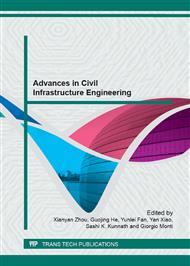p.493
p.498
p.502
p.510
p.515
p.523
p.530
p.535
p.539
Wind Load Characteristics of Tall Building with Atrium
Abstract:
Wind tunnel test of 1:500 rigid model of tall building with atrium was carried out. Based on the experimental results, characteristics of wind pressures on atrium facades and wind loads on the structure were investigated in detail. The results show that the formation of flow separation on the building top plays a critical role in the generation of wind pressures on the atrium facades. Meanwhile, wind pressure coefficient distributions on the atrium facades are found to be relatively uniform. Moreover, the horizontal and vertical correlations of pressure coefficient exhibit high at most locations on atrium facades. With the increasing of the opening ratio, the mean wind pressure coefficients first decreased and then stabilized, and the fluctuating wind pressure coefficients first decreased and then increased. A design guideline for the wind-resistant design of atrium facades was proposed, and the results predicted by the proposed guideline were in good agreement with those from the wind tunnel tests, indicating that the proposed guideline can be used in engineering applications. When the opening ratio is no more than 5.33%, the effect of the facade pressures within the atrium on the wind loads on the structure can be ignored. For such cases, the wind-resistant design for a tall building with atrium can refer to that of a similar shape tall building without atrium.
Info:
Periodical:
Pages:
515-522
Citation:
Online since:
January 2013
Authors:
Price:
Сopyright:
© 2013 Trans Tech Publications Ltd. All Rights Reserved
Share:
Citation:


